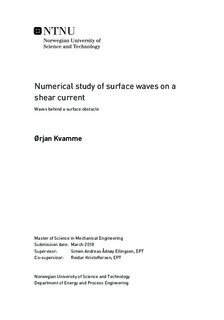| dc.description.abstract | This master's thesis has made investigation into waves and currents interaction numerically by the use of an oscillating cylinder as a wave-maker. Three cases were investigated: still water, uniform flow and linear shear current. A small parameter parameter study was performed to compare OpenFOAM's damping option to other existing wave damping tools in other competing software. The results showed that, while the damping parameter $f$ can be estimated through linear scaling law, this serves at best as a first guess. The wave damping was applied in all cases, proving a helpful tool for damping also on a shear current. The still water case validated the use of the oscillating cylinder as a wave-maker, where linear surface waves were created and checked against the dispersion relation. The amplitude of the waves produced by the cylinder proved to be around half of the excitation amplitude. Both the uniform flow case and the linear shear case looked into the non-linear effects of a moving oscillating cylinder at an excitation frequency near to the Doppler resonance frequency, $\tau = 1/4 = \varsigma U/g$. Non-linearity was in both cases proven to occur upstream of the cylinder. In the uniform flow case, it caused wave breaking and overturning, while linear waves was produced downstream. In the linear shear case, a positive vorticity $S$, was shown to assist the waves downstream, while it opposed the waves upstream.
This lead to smaller wavelengths downstream and larger wavelengths upstream compared to a case zero vorticity. The dispersion relation showed good concurrence both downstream and upstream with non-linear corrections of the dispersion relation upstream. Downstream, in the linear regime, the relative error for the wavelength was shown to be $4 \% $, $6 \% $ and $3.7 \% $, for the respective cases. | |

